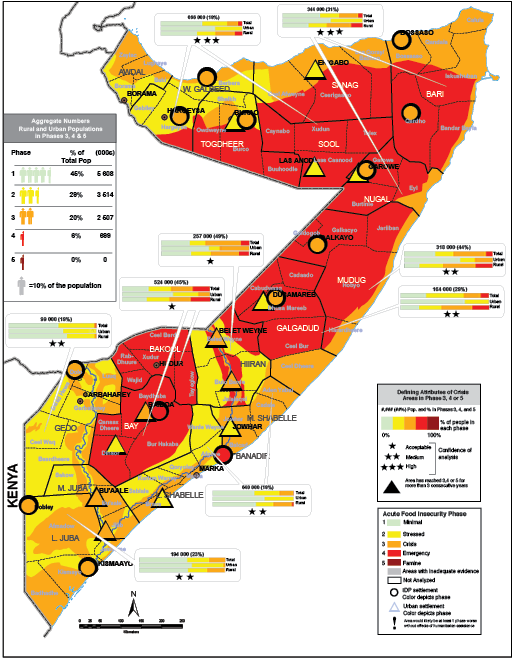FSNAU Food Security Quarterly Brief, April 2017
Issued: May 29, 2017
- Results from the post-Jilaal assessment and recent SMART surveys indicate that Crisis (IPC Phase 3) and Emergency (IPC Phase 4) levels of acute food insecurity persist in many areas of Somalia
- Accordingly, approximately 3.2 million people will be in Crisis and Emergency (IPC Phase 3 and 4) and are in need or urgent humanitarian assistance through June 2017, An additional 3.5 million will be Stressed (IPC Phase 2) and are in need of livelihood protection support between now and June.
- Levels of acute malnutrition are Critical (15-30% GAM) among rural pastoral populations of Sool, Sanaag, Bari, Nugaal and agropastoral populations of Bay Regions and among Internally Displaced Persons (IDPs) in Baidoa and Mogadishu. Mortality has also increased in all of these locations.

- Mortality has increased in all the surveyed areas. However, the increases are statistically significant only in rural Bay and among IDPs in Baidoa. For rural parts of Bay region, Crude Death Rates (CDR) and Under-Five Death Rate (U5DR) were 2.43/10 000/day and 4.65/10 000/day, respectively. While the primary cause of death reported by households in Bay is diarrhea linked to the outbreak and spike of AWD/Cholera in the Region, these death rates exceed the thresholds for Famine for mortality indicators (CDR of 2/10 000/day and U5DR of 4/10 000/day).
- Food security assessments conducted in late March by FSNAU also indicate severe pasture and water shortage and significant loss of livestock in northeastern and central regions, leading to further deterioration of the food security in Hawd, Addun and central parts of Cowpea Belt livelihood zones, Bakool pastoral and agropastoral areas of Hiran deteriorated from Crisis (IPC Phase 3) to Emergency (IPC Phase 4). Atypical livestock off-take (high death and distress sale), accumulated debts, destitution, and displacement have been observed across most parts of these livelihoods.
- Humanitarian assistance has likely contributed to mitigating extreme levels of acute food insecurity in worst-affected areas, however the observed deterioration calls for scaling up of assistance that reflects the increased needs due to both the deteriorating situation as well as increased needs due to substantial drought related displacement.
- Data from UNHCR indicates that an estimated 437 530 persons were displaced due to drought or drought related factors
across Somalia in the first quarter of 2017. - Despite access and security challenges, humanitarian assistance has been gradually scaled up during the first quarter
of 2017. - Data from the Nutrition Cluster on treatment and feeding centers for acutely malnourished indicate a sharp increase in
new cases (55,000 in March, 46,000 in February and 25,000 in January). - New admissions to treatment and feeding centers have increased between January and March 2017, reflecting the
deteriorating nutrition situation across most parts of the country. - If the delivery of humanitarian assistance is not scaled up further and sustained and the Gu rains continue to perform
poorly, food security and nutrition conditions may deteriorate further. - Data from the Health Cluster/WHO indicates 19 004 AWD/cholera cases and 425 deaths across Somalia in the first
quarter of 2017 with an overall Case Fatality Rate (CFR) of 2.2 percent, well above the above the emergency threshold
of 1.0 percent. Ongoing efforts aimed at controlling the spread of AWD/cholera should be stepped up and should be
integrated with other support interventions. - Provision of livelihood support would also be necessary in order to prevent further displacement, protect further loss of
livestock and ensure that farmers are able to take advantage of the Gu rains for crop cultivation.
Download the full report


















